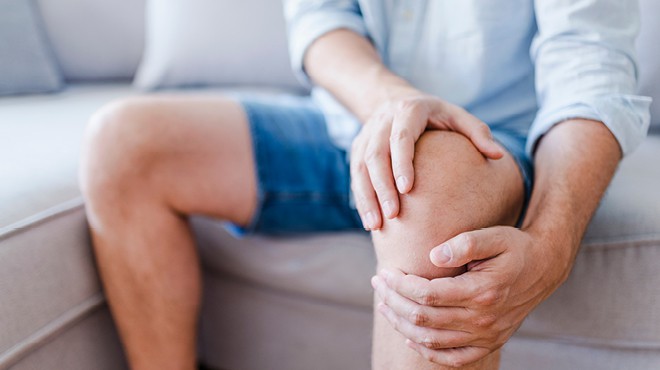Knee pain is the second most common complaint among patients after back pain and is the 3rd leading cause of chronic pain in the country.
We certainly see a large number of patients come through our clinic with knee pain that they’ve been having problems with ranging from a few days to 10+ years.
This pain can be a huge influence on your life from impacting your mobility to your enjoyment of daily activities like spending time with friends and family to your favorite hobbies.
But is your sore knee really a cause for concern?
Not all knee pain is something to worry about. Even more often, knee pain is not actually caused by the knee itself, it can be caused by joints above and below the knee like hips and ankles. In this blog, we discuss if your knee pain really is a problem or whether you have an isolated knee injury.
Is Your Knee Pain Really a Knee Problem?
Knee pain can be tricky to figure out – especially if it’s chronic. The thing is, knee pain is often not caused because of the knee. The true source is likely from above or below. Think about it….The knee joint is essentially two bones stacked on top of each other held together by ligaments, muscles, tendons, and other soft tissues.
The knee is sturdy and strong until it begins to bend one way or another. For this reason, I always say “the knee is the innocent bystander between the ankle and hip.” If our foot and ankle begin to change shape or angle over time, that’ll cause the knee to bend inwards and the hip to rotate in-causing the knee to get stressed.
Likewise, if we have a joint or muscle imbalance in our hip, that can control the alignment of our knee and the weight distribution experienced on it. So, not just treating the knee, but looking elsewhere for the TRUE SOURCE is the key to successfully resolving knee pain for good.
How Do You Know If Your Knee Pain Really IS A Knee Problem?
Initially, you should pay attention to how and when your knee pain started.
If you’ve had a fall or some kind of trauma directly to your knee, and you experience knee pain or swelling shortly after, odds are pretty good you have an isolated knee problem. People who perform regular, intense activities like soccer, hiking, skiing, football, and basketball are much more at risk for an isolated knee injury. Typically, you’ll know exactly when and how you hurt your knee. You may even recall a specific pop or strain of some kind.
If your knee pain is something that you “just woke up with” one day and doesn’t seem to be going away, it is likely that you are dealing with a soft tissue issue as a result of a muscle imbalance.
Osteoarthritis (OA) of the knee is another example of a knee problem that could really be a knee problem.
However, this one is tricky because if you’re over the age of 50, you most likely have OA in your knee, and it will show up on your X-ray whether you have knee pain or not. So what commonly happens is that if you’ve had knee pain for a while, and you get an X-ray that shows you have OA, the OA will get blamed for your knee pain.
So yes – knee OA can be an isolated knee problem – but knee OA tends to be an over-diagnosed source of knee problems. After all, your arthritis didn’t just show up in your knee 2 weeks ago did it?
It is more likely that it has been there for some time and you just haven’t noticed it. The changes in the tissues around it are a more likely culprit, usually a combination of tight and weak muscles that increase the force experienced at the joint which is why the arthritis pain hurts so much and why we can help ease the pain with stretches and strengthening exercises.
What Are The Clues That Tell You Your Knee Pain Might NOT Be A Knee Problem?
One of the biggest clues that you’ve missed the correct source of your knee pain is that it doesn’t go away no matter what you’ve tried, or it keeps coming back.
This is the biggest complication I see with folks suffering from long-lasting knee pain. They’ve iced it, taken pain medication, foam rolled, stretched, and strengthened – but their pain doesn’t get resolved. And once your problem becomes chronic, knee doctors start to get involved.
This is great if you’ve actually got a knee problem. But if your knee pain is a symptom of something else, then you risk getting recommended unnecessary knee surgeries or procedures.
I spoke to a woman the other day who had surgery on her knee to clean out some cartilage and wear and tear from arthritis. It was supposed to be a “quick recovery” and take her pain away. Well, three months later, her knee is feeling worse than pre-surgery.
And to fix the new pain she has, they tell her she will need even more procedures. Her initial problem wasn’t coming from knee OA – it was coming from something else. And now she’s going to have even more problems because she had surgery she never needed.
How Can I Avoid Unnecessary Procedures If My Knee Isn’t The Problem?
The biggest reason is because of the over-reliance on imaging to form a diagnosis and treatment plan. Now don’t get me wrong. Imaging is a good thing and a powerful tool when used properly. However, when If you’re over 50, and you get an X-ray or MRI taken of your knees, there is a 60-80% chance they’ll find arthritis or meniscus (cartilage) tears, whether you have knee pain or not. That’s because these are normal changes that occur as you age.
So if you’ve got knee pain, and your doctor wants to do some imaging, there is a very good chance they’ll find one or more of these changes in your knee – and then blame your knee pain on it. But here’s the thing – and research backs this up – there is no way to tell for certain from a picture of your knee where the true cause of your pain is coming from. The only way to tell if what you see in the imaging is actually the cause of your pain is with proper movement testing. If you don’t do that, you risk getting an unnecessary procedure when the real problem might be coming from somewhere else.
In Conclusion…
If your knee pain seems to come on slowly or out of nowhere, if you have trouble pinpointing exactly where the pain is if it moves around and changes from day to day, or if it runs up or down your leg – there is a good chance your knee pain is a symptom of a mechanical problem elsewhere – typically your back, hip or your ankle.
Before you think about getting images of your knee or undergoing some kind of surgery or procedure, you’ll want to make sure you get a thorough screen from a mechanical pain expert. Never rely on imaging to tell you the full story.
Remember that knee problems can be resolved 80% of the time without procedures or surgery. You just have to have some patience and make sure you’re working with someone who understands mechanical pain and the importance of looking at the whole body – beyond just where the pain is.
Are You Looking For Help With Knee Pain Now?
Although your knee pain might not be anything serious if you’ve been suffering with it for a long period of time and it’s impacting your ability to enjoy your day-to-day activities, we would recommend you seek help from a physical therapy clinic like us.
Sign up for a free knee pain discovery visit with one of our specialists to see if we would be a good fit to help you eliminate your knee pain for good! Request your free knee pain discovery visit with one of my specialists by filling in our simple web form or calling us on (712) 560-0460.
Not Sure Whether Physical Therapy Is Right For You?
If you’re not quite ready to come into our clinic and see us, we have our free knee pain report you can download to find out how to stop chronic, daily annoying knee pain.
Download your free report here.
Other Ways To Help You Stay Active And Pain-Free
Download one of our free reports packed with proven tips to help relieve pain without painkillers – Back Pain, Hip Pain, Knee Pain or Neck and Shoulder Pain
Read our blog – What Is The Best Treatment For Arthritis In The Lower Back?
Read our blog – 5 Common Causes of Shoulder Pain That Physical Therapy Can Help
Follow us on social media- Impact Physical Therapy and Wellness
Proudly voted #1 for Physical Therapy at the Siouxland’s Choice Awards (2022) and proud Physical Therapy and Recovery Session provider to the Sioux City Bandits.
Dr. Keith Roed, Physical Therapist is a Certified Manual Physical Therapist and soft tissue expert using a variety of techniques including Astym, Cupping and EPAT. He is the team Physical Therapist for Sioux City’s Professional Indoor Football Team, the Sioux City Bandits. He owns Impact Physical Therapy & Wellness in Sioux City and Akron, IA.
Tags: knee pain, knee problems, physical therapy, prevent surgery, meniscus pain, knee sprain, knee strain, knee ligament sprain, patella pain, patellofemoral pain, patellar tendinitis, Jumper’s knee, Runner’s knee
- Harnessing the Power of Regenerative Technologies: EMTT and ESWT for Arthritic Knee Pain Relief - May 19, 2024
- Fix Your Discomfort Fast With These 3 Neck Pain Exercises - April 18, 2024
- Learn How to Relieve Rotator Cuff Pain at Night - March 26, 2024


